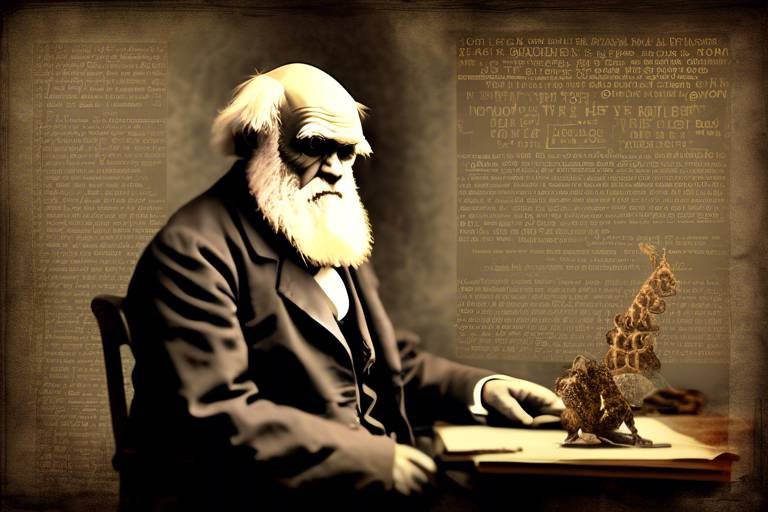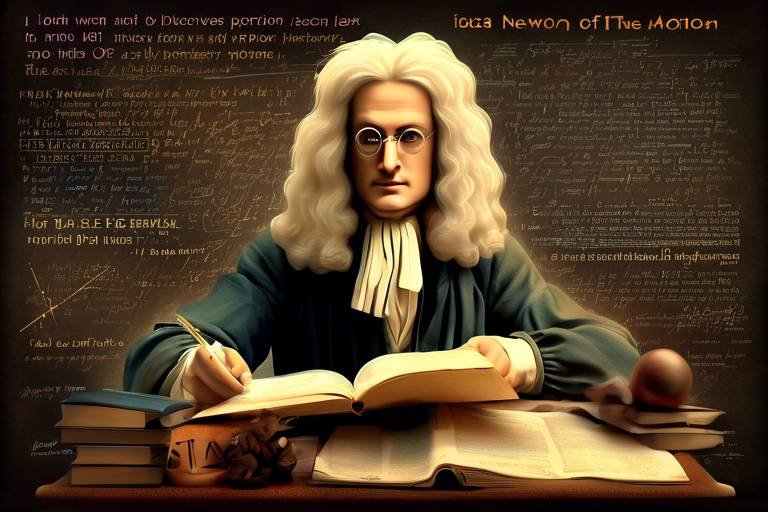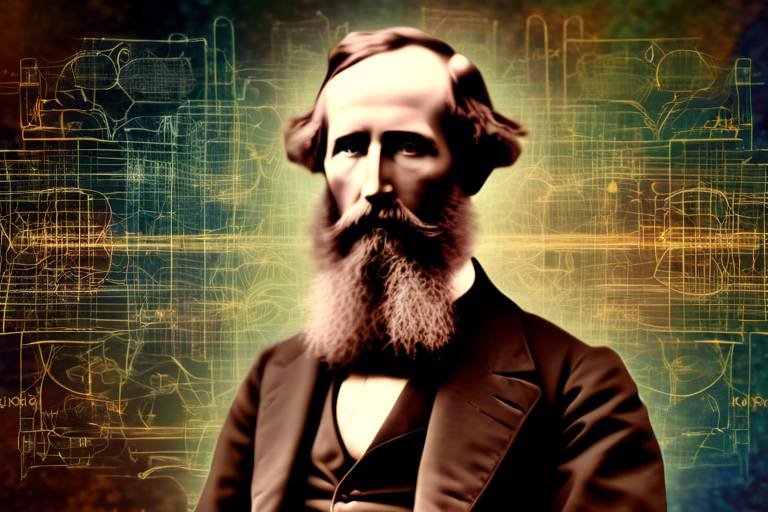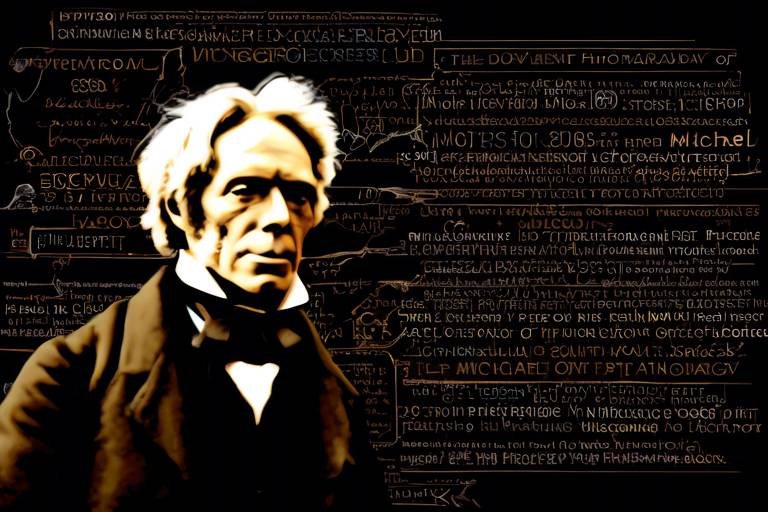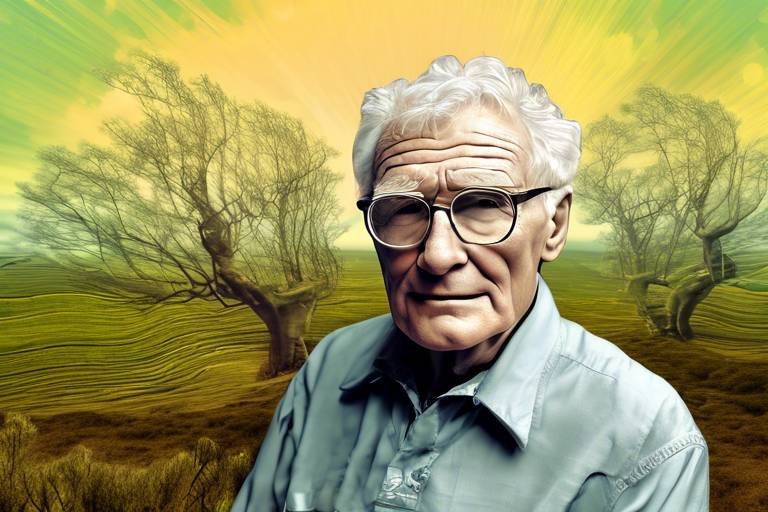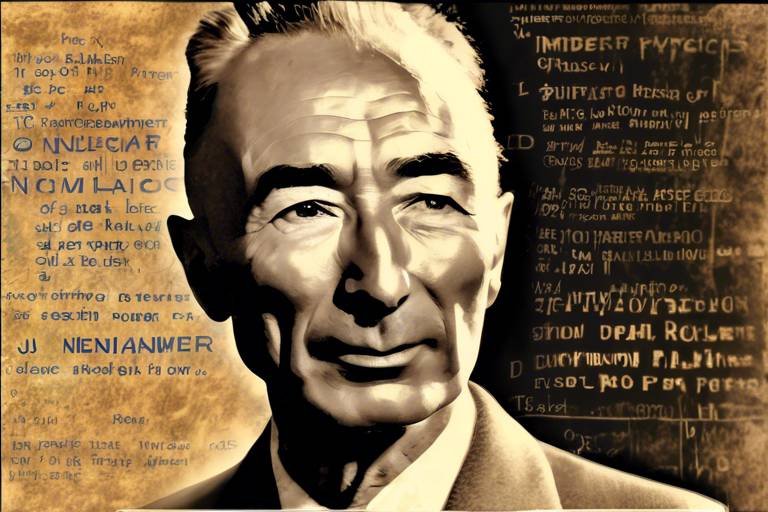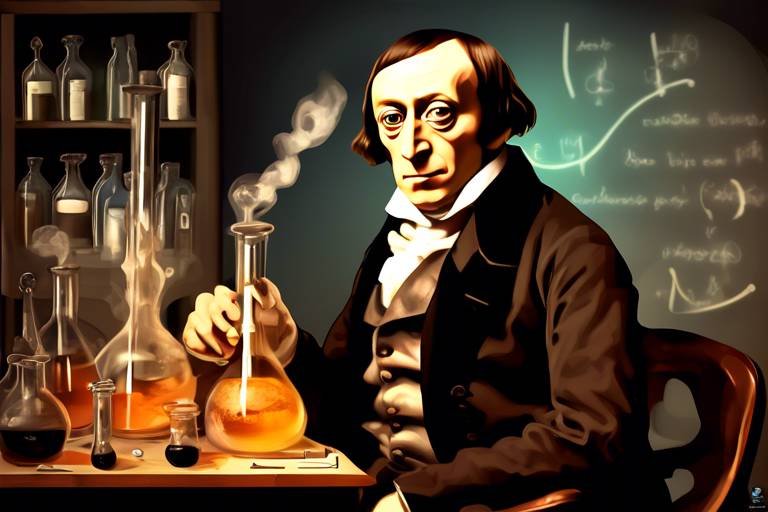The Contributions of Thomas Edison to Technology and Innovation
When we think about the pioneers of technology, Thomas Edison often comes to mind as one of the most influential figures in history. His name is synonymous with innovation, and his inventions have left an indelible mark on the fabric of modern society. With over 1,000 patents to his name, Edison's contributions span across various fields, including electricity, sound recording, and motion pictures. This article explores his groundbreaking inventions and innovations, highlighting how they transformed not only industries but also the everyday lives of people around the globe.
Edison's journey began in humble beginnings, yet his insatiable curiosity and relentless pursuit of knowledge set him on a path to greatness. His ability to envision the future and create solutions to complex problems was nothing short of remarkable. But what made Edison truly special was not just his inventions, but also his entrepreneurial spirit that led to the establishment of numerous companies, including the famous General Electric.
Throughout this article, we will delve into Edison's early life, key inventions, and the lasting impact he had on technology and society. From the incandescent light bulb that illuminated our homes to the phonograph that changed how we experience music, Edison's legacy is a testament to the power of innovation and creativity. So, let’s take a closer look at his life and contributions that continue to inspire generations of inventors and entrepreneurs.
Born on February 11, 1847, in Milan, Ohio, Thomas Edison was the last of seven children in a modest family. His early life was marked by a series of challenges, including a hearing impairment that led to his being labeled as 'difficult' by his teachers. However, this adversity only fueled his desire to learn and experiment. Edison's mother, a former school teacher, played a crucial role in nurturing his curiosity by homeschooling him and encouraging his inventive spirit.
By the age of 12, Edison had already started selling newspapers and candy on trains, showcasing his entrepreneurial flair. His early experiences in the world of business, coupled with his fascination for science, laid the groundwork for his future innovations. Edison's relentless pursuit of knowledge led him to conduct his own experiments, often using materials he could find around him, which would eventually lead to his groundbreaking inventions.
Throughout his career, Edison was responsible for a multitude of inventions that not only transformed industries but also changed the way people lived. Some of his most significant inventions include:
- Phonograph: The first device capable of recording and reproducing sound.
- Incandescent Light Bulb: A practical electric light source that replaced gas lamps.
- Motion Pictures: Pioneering technology that laid the foundation for the film industry.
Each of these inventions was groundbreaking in its own right, but what truly set Edison apart was his ability to combine science with practical application. He didn't just invent for the sake of invention; he created products that addressed real-world problems, making life easier and more enjoyable for everyone.
Edison's work on the electric light bulb was a game-changer. Before his innovations, people relied on oil lamps and candles for light, which were not only inefficient but also hazardous. The incandescent light bulb brought a new era of illumination that changed the way people lived and worked, extending productive hours into the night.
The journey to perfecting the incandescent light bulb was fraught with challenges. Edison and his team experimented with thousands of materials to find the right filament that would burn brightly without breaking. Ultimately, they discovered that a carbonized bamboo filament could last over 1,200 hours, making it commercially viable. This innovation not only revolutionized lighting but also paved the way for the widespread adoption of electric power in homes and businesses.
To support the use of electric light bulbs, Edison established the first electric power distribution system in New York City in 1882. This system was revolutionary, providing electricity to homes and businesses and laying the groundwork for modern electrical grids. Edison's vision for a world powered by electricity was not just a dream; it became a reality, leading to the urban development we see today.
The phonograph, invented in 1877, was one of Edison's most celebrated inventions. It was the first device capable of recording sound, allowing people to listen to music in the comfort of their homes. This invention not only transformed the music industry but also paved the way for the development of sound recording technology. Imagine a world without music as we know it—Edison's phonograph made that world a reality.
Edison's contributions to the film industry were equally significant. He developed early motion picture technology that laid the foundation for cinema as we know it today. His inventions, such as the Kinetoscope, allowed individuals to view moving images, setting the stage for the birth of the film industry. Edison's influence on film technology inspired countless filmmakers and innovators, and his legacy lives on in every movie we watch.
Today, Thomas Edison's legacy continues to inspire inventors and entrepreneurs around the world. His relentless pursuit of innovation and his ability to turn ideas into reality serve as a guiding light for those who aspire to make a difference. Edison's story is a reminder that with curiosity, determination, and a bit of creativity, anyone can change the world.
- What was Thomas Edison's most famous invention? The incandescent light bulb is often considered his most famous invention, revolutionizing the way people illuminated their homes.
- How many patents did Thomas Edison hold? Edison held over 1,000 patents throughout his lifetime, showcasing his prolific inventiveness.
- What impact did Edison have on the film industry? Edison's early work in motion picture technology laid the groundwork for the film industry, influencing the way movies are made and viewed today.

Early Life and Education
Thomas Edison was born on February 11, 1847, in Milan, Ohio, a small town that would serve as the backdrop for his early curiosity and inventive spirit. From a young age, Edison exhibited a fascination with the world around him, often conducting small experiments that would lay the groundwork for his future innovations. However, his journey was not without its challenges. Edison's formal education was cut short when he was just seven years old. His teacher deemed him "difficult" and "slow," leading his mother, Nancy Edison, to take him out of school and educate him at home. This decision proved to be pivotal, as it allowed Edison the freedom to explore his interests without the constraints of a traditional classroom.
During his formative years, Edison's home became a laboratory of sorts, filled with books and materials that fueled his insatiable curiosity. He was particularly drawn to science and technology, often experimenting with chemicals and electrical devices. His mother played a crucial role in nurturing his interests, encouraging him to read and learn about various subjects, which in turn helped him develop a strong foundation in both science and mathematics. This early education, combined with his relentless curiosity, set the stage for his future contributions to technology.
By the age of 12, Edison took on his first job as a newsboy on the Grand Trunk Railroad, where he sold newspapers and candy to passengers. This entrepreneurial spirit was evident even then, as he would often use his earnings to fund his experiments. It was during this time that he began to learn about telegraphy, a skill that would later prove invaluable. After a brief stint working as a telegraph operator, Edison realized that he had a knack for invention and innovation. He began to experiment with telegraph devices, which ultimately led to his first patent at the age of 21 for an improved voting machine.
In essence, Edison's early life was a tapestry woven with threads of curiosity, resilience, and an unyielding desire to learn. His unconventional education and early experiences not only shaped his character but also ignited a lifelong passion for invention. This foundation would eventually lead him to become one of the most prolific inventors in history, holding over 1,000 patents and transforming industries across the globe.

Key Inventions
When we think about the landscape of modern technology, it’s nearly impossible to overlook the monumental contributions of Thomas Edison. His inventive prowess not only paved the way for numerous industries but also fundamentally altered the way we experience everyday life. With over 1,000 patents to his name, Edison’s innovations span a variety of fields, but a few stand out as particularly transformative.
One of Edison's most famous inventions is the phonograph, which was the first device capable of recording and reproducing sound. Imagine a time when music was only live, and then suddenly, you could capture a melody and play it back at will! This invention not only revolutionized the music industry but also laid the groundwork for future audio technologies. The phonograph made it possible for people to enjoy music in their homes, creating a new culture of listening that was previously unimaginable.
Next, we can't ignore the incandescent light bulb, a beacon of innovation that illuminated homes and streets around the globe. Before Edison's work, lighting was largely reliant on gas lamps and candles, which were not only dim but also dangerous. Edison’s refinement of the incandescent bulb involved experimenting with various materials for the filament, eventually leading to a practical and long-lasting design. This invention marked a pivotal moment in the transition from gas to electric lighting, facilitating a more productive and safer environment for work and leisure.
Furthermore, Edison's advancements in motion pictures played a crucial role in the birth of the film industry. He developed the Kinetoscope, a device that allowed individuals to view moving pictures through a peephole. Although this was not the first motion picture device, it was one of the first to gain commercial success. Edison's contributions set the stage for the cinematic experiences we enjoy today, paving the way for filmmakers to tell stories through the art of film.
To summarize, here are some of Edison's key inventions that have left a lasting impact:
- Phonograph: The first device to record and reproduce sound.
- Incandescent Light Bulb: A practical solution for electric lighting that changed the world.
- Kinetoscope: An early motion picture device that laid the foundation for cinema.
Each of these inventions not only showcases Edison's brilliance but also reflects his ability to see beyond the present and envision a future filled with possibilities. His relentless pursuit of innovation and improvement has inspired countless inventors and entrepreneurs, reminding us that creativity and hard work can bring revolutionary ideas to life.

Electric Power and the Light Bulb
When you think of Thomas Edison, one of the first things that comes to mind is the incandescent light bulb. This invention was not just a simple flick of a switch; it was a revolutionary moment in history that illuminated homes and streets alike, transforming the very fabric of daily life. Before Edison's innovations, people relied on candles, gas lamps, and other less efficient means to light their surroundings. Can you imagine a world where darkness ruled the night? Edison's work on electric power systems and the light bulb was a beacon of hope for a brighter future.
Edison's journey to creating the incandescent light bulb was fraught with challenges. He faced numerous obstacles, including the quest for the right filament material that would burn long enough to be practical. After countless experiments, he finally hit the jackpot with carbonized bamboo filaments, which could last over 1,200 hours. This breakthrough was pivotal, but the light bulb was just one part of a larger puzzle that needed to be solved: how to deliver electricity efficiently to homes and businesses.
The establishment of electric power distribution systems was a monumental task that Edison undertook with tenacity. He envisioned a world where electricity was readily available to everyone, not just the privileged few. In 1882, Edison opened the first commercial power station, the Pearl Street Station in New York City. This station served as a model for future electric power plants, providing direct current (DC) electricity to customers in the surrounding area. The success of this venture marked the beginning of a new era in energy consumption.
To give you a clearer picture of Edison's impact on electric power, here's a brief overview of some key milestones:
| Year | Event |
|---|---|
| 1879 | Successful demonstration of the incandescent light bulb |
| 1880 | Patent granted for the light bulb |
| 1882 | Opening of the Pearl Street Station |
| 1890 | Expansion of electric power distribution systems |
With the introduction of the light bulb and the establishment of power distribution systems, cities began to transform. Streetlights lit up the roads, allowing people to feel safer at night. Businesses could operate longer hours, and social gatherings could continue well after sunset. The world was awakening to the possibilities that electricity provided, all thanks to Edison's relentless pursuit of innovation.
But let's not forget the competition that arose during this electrifying time. Edison's direct current system faced challenges from Nikola Tesla and George Westinghouse, who championed alternating current (AC) systems. This rivalry, often referred to as the “War of Currents,” showcased the fierce battle to determine the future of electricity distribution. Ultimately, while Edison’s contributions were monumental, AC systems became the standard for long-distance power transmission.
In conclusion, Edison's work on the electric light bulb and power distribution systems not only changed how people lived but also laid the groundwork for the modern electrical infrastructure we rely on today. His innovations sparked a chain reaction of technological advancements that continue to illuminate our lives. So next time you flick a switch, remember the brilliant mind of Thomas Edison and the darkness he helped to dispel.

Incandescent Light Bulb
The invention of the marked a pivotal moment in the history of technology. Before Edison's work, lighting was primarily provided by gas lamps or candles, which were not only inefficient but also posed significant safety hazards. Edison’s journey to create a practical and long-lasting light bulb was fraught with challenges, yet it showcased his relentless determination and innovative spirit. His initial experiments began in the late 1870s, where he meticulously tested various materials to find the perfect filament that would glow brightly without burning out too quickly.
After countless trials, Edison discovered that a carbonized bamboo filament could last over 1,200 hours, a groundbreaking achievement at the time. This discovery was not merely a stroke of luck; it was the result of his scientific method, which combined trial and error with a keen understanding of electrical resistance. Imagine the excitement in Edison's lab as he finally lit up a bulb that could illuminate a room for hours on end!
To put Edison's achievement into perspective, let’s take a look at the impact of the incandescent light bulb on everyday life:
| Aspect | Before Edison | After Edison |
|---|---|---|
| Lighting Source | Gas lamps, candles | Electric light bulbs |
| Safety | High risk of fire | Significantly safer |
| Efficiency | Low efficiency, frequent replacements | Long-lasting, energy-efficient options |
| Accessibility | Limited to urban areas | Widespread availability |
The incandescent light bulb did not just change how we illuminate our homes; it transformed the very fabric of society. With the ability to light up spaces after dark, people could extend their working hours, leading to a surge in productivity. Imagine the late-night brainstorming sessions or the cozy evenings spent reading a book—none of this would have been possible without Edison's revolutionary invention.
Furthermore, the widespread adoption of electric lighting paved the way for the establishment of electrical power distribution systems, which Edison was also instrumental in developing. The combination of these two innovations laid the groundwork for modern urban living, reshaping cities and lifestyles in ways that continue to resonate today.
In essence, Edison's work on the incandescent light bulb was more than just an invention; it was a catalyst for change. It illuminated the path for future innovations and served as a reminder of how one man's vision could light up the world.

Power Distribution Systems
When we think of the modern world, it's hard to imagine life without electricity. Yet, the seamless flow of power that we often take for granted was not always a reality. Thomas Edison played a pivotal role in the development of electric power distribution systems, laying the foundation for how electricity is delivered to homes and businesses today. His contributions in this area were not merely technical achievements; they were revolutionary changes that dramatically altered the fabric of society.
Edison's journey into electrical power distribution began with his invention of the incandescent light bulb. However, creating a light bulb was just the tip of the iceberg. Edison realized that for his invention to be useful, there needed to be a reliable way to deliver electricity to consumers. This led him to develop the first practical power distribution system, which was launched in 1882 in New York City. The system was designed to provide electricity to customers in a way that was efficient and manageable.
To understand the significance of Edison's work, let’s consider the components of his power distribution system:
- Central Power Station: Edison established the first commercial power station, which generated electricity for a specific area. This was a game changer, as it centralized power generation.
- Distribution Network: He devised a network of underground cables to distribute electricity, ensuring that it could reach homes and businesses safely.
- Metering System: To measure electricity usage, Edison introduced meters, allowing customers to be billed for their consumption. This was crucial for the economic viability of electric power.
The success of Edison's power distribution system marked a significant shift in how people lived and worked. Imagine a world where streets were dark after sunset, where productivity halted with the setting sun. Edison's innovations changed that narrative. With electric light, people could work late into the night, businesses thrived, and cities became vibrant hubs of activity, illuminated by the glow of electric lights.
However, Edison's journey was not without its challenges. He faced fierce competition from other inventors and entrepreneurs, most notably George Westinghouse, who championed alternating current (AC) systems. While Edison was a proponent of direct current (DC), which he believed was safer and more efficient for short distances, the debate between AC and DC became a defining moment in the history of electricity. Ultimately, AC systems became the standard due to their ability to transmit power over long distances more effectively.
Despite the challenges, Edison's power distribution systems laid the groundwork for the electrical grids we rely on today. His vision of a world powered by electricity has become a reality, influencing not just our daily lives but also the growth of industries, urban development, and technological innovation.
In summary, Edison's contributions to power distribution were nothing short of transformative. They established the framework for the electricity infrastructure that supports our modern society. His work not only illuminated homes but also sparked an era of innovation that continues to thrive.
What was Thomas Edison's role in electricity distribution?
Edison developed the first practical power distribution system, which included a central power station, underground distribution networks, and metering systems to charge customers for their electricity usage.
How did Edison's inventions influence modern life?
Edison's inventions, particularly in electric power distribution, transformed urban life by allowing businesses to operate after dark and enabling cities to grow and thrive with electric lighting.
What challenges did Edison face with his power distribution systems?
Edison faced competition from other inventors, particularly George Westinghouse, who promoted alternating current (AC) systems. The debate between AC and direct current (DC) systems was a significant challenge in the evolution of electrical power.

Phonograph and Sound Recording
The invention of the phonograph by Thomas Edison in 1877 marked a revolutionary moment in the realm of sound recording and playback technology. Imagine a world where music could only be enjoyed live, where the beauty of a symphony or the charm of a folk tune vanished into thin air once the performance ended. Edison's phonograph shattered that limitation, allowing sounds to be captured and replayed, forever changing the way we experience music and spoken word.
Edison’s journey to creating the phonograph was not just a stroke of luck; it was a combination of his relentless curiosity and scientific experimentation. Initially, he wanted to develop a device that could record telegraph messages. Instead, he stumbled upon a method to record sound using a tin foil cylinder. This groundbreaking invention was not just a technical feat; it was a glimpse into a future where sound could be preserved and shared.
To give you an idea of how revolutionary this was, consider the following table that outlines some key features of the phonograph:
| Feature | Description |
|---|---|
| Recording Medium | Tin foil cylinder, later replaced by wax cylinders |
| Playback Method | Needle that vibrates to reproduce sound waves |
| First Recorded Sound | Edison's voice saying "Mary had a little lamb" |
| Impact on Music | Enabled music to be recorded and distributed widely |
The phonograph did not just change how we listened to music; it also opened the door to a new industry. With the ability to record sound, artists could now reach audiences far beyond their immediate surroundings. This innovation paved the way for the music industry as we know it today, allowing for the creation of records and eventually the modern music distribution systems that we rely on.
Moreover, the phonograph's influence extended beyond music. It played a crucial role in the world of entertainment and education. Imagine classrooms where students could listen to lectures from renowned figures or actors performing dramatic readings, all captured and replayed through Edison's invention. This concept of recorded sound has evolved into what we now recognize as podcasts and audiobooks, showcasing the phonograph's lasting legacy.
However, Edison's journey was not without challenges. The initial design of the phonograph was rudimentary, and he faced skepticism from those who could not envision a market for recorded sound. Yet, his perseverance paid off. As technology advanced, so did the phonograph, transitioning from the simple tin foil to more sophisticated materials and designs, ultimately leading to the creation of the gramophone.
In conclusion, Edison's phonograph was a remarkable leap forward in sound recording technology. It not only transformed the music industry but also changed how society interacts with sound. Today, we take for granted the ability to listen to our favorite songs at the touch of a button, but it all started with Edison's innovative spirit and his desire to capture the fleeting beauty of sound.
- What was the first sound ever recorded on the phonograph? The first sound recorded was Thomas Edison's voice reciting "Mary had a little lamb."
- How did the phonograph impact the music industry? It allowed music to be recorded and distributed widely, leading to the creation of the record industry.
- What materials were used in the early phonographs? The first phonographs used tin foil cylinders, which were later replaced by wax cylinders for better sound quality.
- Are there modern equivalents to the phonograph? Yes, modern technologies like digital recorders and streaming services are the descendants of Edison's phonograph.

Impact on the Film Industry
Thomas Edison was not just a pioneer of electrical innovation; he was also a significant figure in the evolution of the film industry. His contributions to early motion picture technology laid the groundwork for what would become one of the most influential forms of entertainment in the world. Imagine a world without movies—no blockbuster hits, no indie films, and no cinematic masterpieces. Edison's inventions made it possible for stories to be told through moving images, captivating audiences and changing the landscape of entertainment forever.
One of Edison's most notable inventions in this realm was the Kinetoscope, a device that allowed individuals to view short films through a peephole. Introduced in 1891, the Kinetoscope was a significant leap forward in film technology. It was a simple yet revolutionary concept: a series of images run through a projector, creating the illusion of motion. This innovation not only entertained but also sparked the imagination of countless inventors and filmmakers who saw the potential of this new medium.
In addition to the Kinetoscope, Edison’s Black Maria Studio, established in 1893, was the first movie studio in the United States. Located in West Orange, New Jersey, this studio was where many of the early films were produced. The studio was designed with a rotating roof to capture the best natural light, highlighting Edison's understanding of the importance of lighting in filmmaking. The films produced here were short, often just a minute or two long, but they laid the foundation for future filmmakers to explore storytelling through film.
It's fascinating to note that while Edison was a driving force in the film industry, he was also a controversial figure. His aggressive business tactics and numerous legal battles over patents and copyright issues created a tumultuous environment for early filmmakers. For instance, he famously sought to control the motion picture industry through his patents, which led to the formation of the Independent Moving Pictures Company by a group of filmmakers who wanted to escape Edison's control. This rivalry ultimately spurred innovation and competition, contributing to the rapid development of the film industry.
The impact of Edison's work in film can be summarized in a few key points:
- Innovation in Technology: Edison's inventions paved the way for future advancements in motion picture technology.
- Establishment of the Film Industry: His studio practices and production methods set standards that are still relevant today.
- Legal Battles: The conflicts he had over patents ignited a spirit of independence among filmmakers, which led to diverse storytelling.
Today, we can trace the roots of modern cinema back to Edison's early experiments. His work not only influenced the technical aspects of filmmaking but also inspired a generation of creators to explore the narrative possibilities that film offered. The magic of cinema that we enjoy today, from epic blockbusters to intimate indie films, owes a great deal to the groundwork laid by Thomas Edison. As we sit in theaters, transfixed by the flickering images on the screen, it's essential to remember the visionary who helped bring this art form to life.
1. What was the Kinetoscope?
The Kinetoscope was an early motion picture exhibition device that allowed individuals to view films through a peephole. It was invented by Thomas Edison and introduced in 1891.
2. How did Edison influence the film industry?
Edison’s inventions, particularly the Kinetoscope and the establishment of the Black Maria Studio, were pivotal in shaping the early film industry. His efforts laid the groundwork for future filmmakers and innovations in motion picture technology.
3. What were some controversies surrounding Edison in the film industry?
Edison was known for his aggressive business tactics and legal battles over patents, which led to the formation of independent filmmaking companies. These conflicts spurred innovation and competition within the industry.
4. Why is Edison's legacy important for modern cinema?
Edison's contributions to film technology and production methods established standards that continue to influence filmmakers today. His work catalyzed the development of the film industry as we know it.

Legacy and Influence
Thomas Edison’s legacy is nothing short of monumental. His relentless pursuit of innovation and his ability to transform ideas into practical inventions have left an indelible mark on technology and society. Edison's work did not merely stop at the inventions themselves; he also established a framework for modern entrepreneurship and research that is still relevant today. His approach to innovation was characterized by a systematic method of experimentation, which has become a cornerstone of scientific inquiry.
One of the most significant aspects of Edison's legacy is his role in fostering the entrepreneurial spirit. He didn’t just invent; he built companies and established industries. For instance, the formation of General Electric in 1892 was a direct result of his vision for electrical power and its applications. This merger of Edison General Electric Company and Thomson-Houston Electric Company set the stage for the modern electrical industry and demonstrated how innovation could lead to substantial economic growth. Edison's ability to recognize the commercial potential of his inventions is a lesson for aspiring entrepreneurs everywhere.
Edison's influence extends beyond just the tools and technologies he created. He inspired generations of inventors and innovators who followed in his footsteps. His famous quote, "Genius is one percent inspiration and ninety-nine percent perspiration," encapsulates his belief in hard work and determination. This mindset is crucial for anyone looking to make a mark in their respective fields. Today, the principles he championed—perseverance, creativity, and the importance of failure as a stepping stone to success—are echoed in the startup culture worldwide.
Moreover, Edison's inventions have had a lasting impact on various sectors. The phonograph revolutionized the music industry, setting the stage for the evolution of sound recording and playback technologies. The incandescent light bulb changed how we illuminate our lives, making it possible for people to work and socialize long after the sun set. His contributions to motion pictures laid the groundwork for the entertainment industry, influencing how stories are told and shared across the globe.
In terms of societal impact, Edison's innovations helped to shape the modern world. The widespread adoption of electric power transformed daily life, leading to increased productivity and improved living standards. Today, we take electricity for granted, but it was Edison's vision and hard work that made it a reality for millions. His establishment of electrical grids and power distribution systems paved the way for the urbanization and industrialization that followed, fundamentally altering the landscape of cities and communities.
In summary, Thomas Edison’s legacy is a tapestry woven with threads of innovation, entrepreneurship, and societal transformation. His contributions continue to resonate in our lives today, reminding us of the power of creativity and the importance of perseverance. As we navigate the complexities of the modern world, Edison's story serves as a beacon for inventors and entrepreneurs, encouraging them to dream big and work diligently to bring their visions to life.
- What were Thomas Edison's most significant inventions? Edison's most notable inventions include the phonograph, the incandescent light bulb, and advancements in motion picture technology.
- How did Edison's work influence modern technology? Edison's systematic approach to invention and his establishment of electrical power systems laid the groundwork for many technologies we use today.
- What is Edison's legacy in entrepreneurship? Edison's entrepreneurial spirit and ability to commercialize his inventions have inspired countless innovators and business leaders.
- How did Edison's inventions impact society? His inventions transformed daily life, increased productivity, and contributed to urban development and the entertainment industry.
Frequently Asked Questions
- What were Thomas Edison's most significant inventions?
Thomas Edison is best known for his inventions such as the phonograph, the incandescent light bulb, and contributions to motion picture technology. Each of these inventions played a crucial role in shaping modern technology and entertainment.
- How did Edison's work on the electric light bulb change society?
Edison's refinement of the incandescent light bulb revolutionized how people lived and worked. It extended the day beyond sunset, allowing for more productivity and leisure time, ultimately transforming urban life and social habits.
- What challenges did Edison face while developing the light bulb?
Developing the light bulb was no easy feat! Edison faced numerous challenges, including finding the right materials for the filament and ensuring the bulb could last long enough to be practical. His persistence paid off, leading to the creation of a reliable light source that changed the world.
- What impact did the phonograph have on music and entertainment?
The phonograph was a game-changer in the music industry. It allowed sound to be recorded and played back, making music accessible to the masses. This innovation paved the way for the recording industry and changed how people experienced music and entertainment.
- In what ways did Edison influence the film industry?
Edison's inventions in motion picture technology laid the groundwork for the film industry. His work on early film cameras and projectors helped to establish cinema as a popular form of entertainment, influencing generations of filmmakers and audiences alike.
- What is Edison's legacy today?
Thomas Edison's legacy is immense. He continues to inspire inventors and entrepreneurs, symbolizing innovation and the relentless pursuit of progress. His contributions to technology and society remain relevant, reminding us of the power of creativity and persistence.



